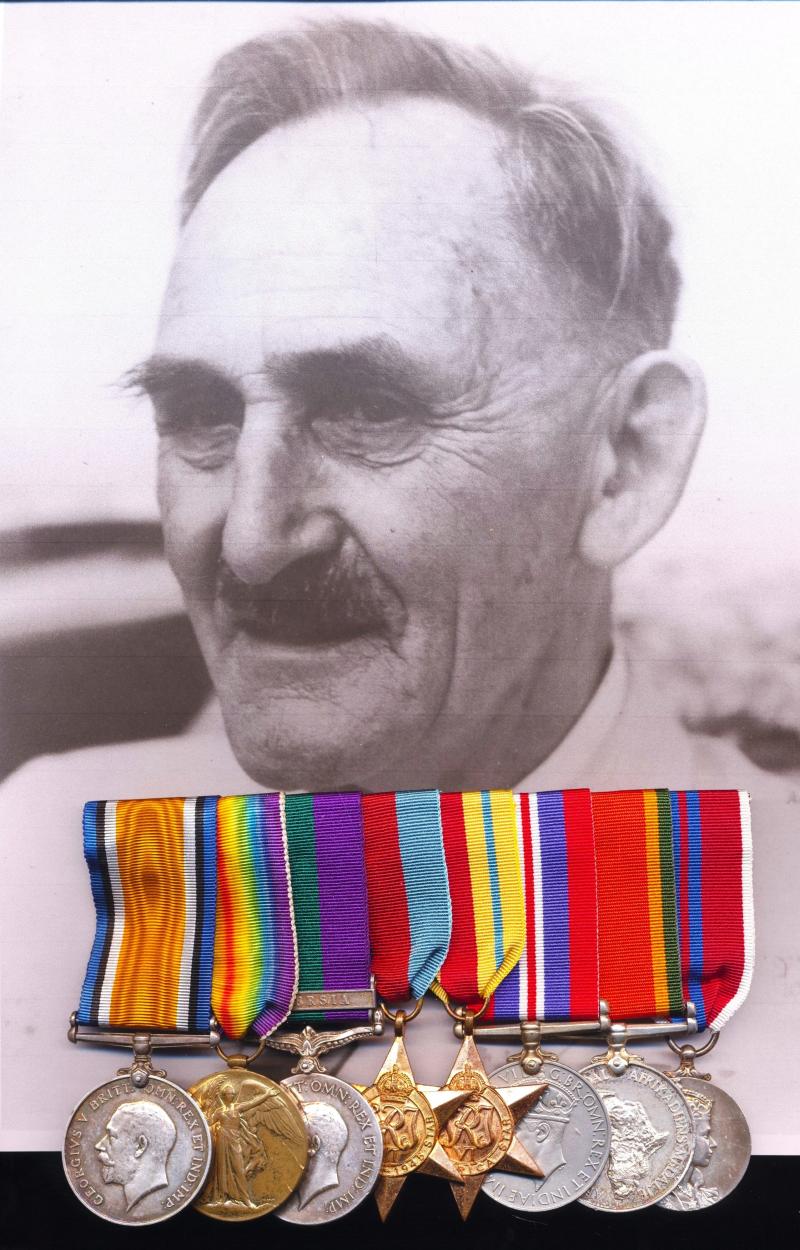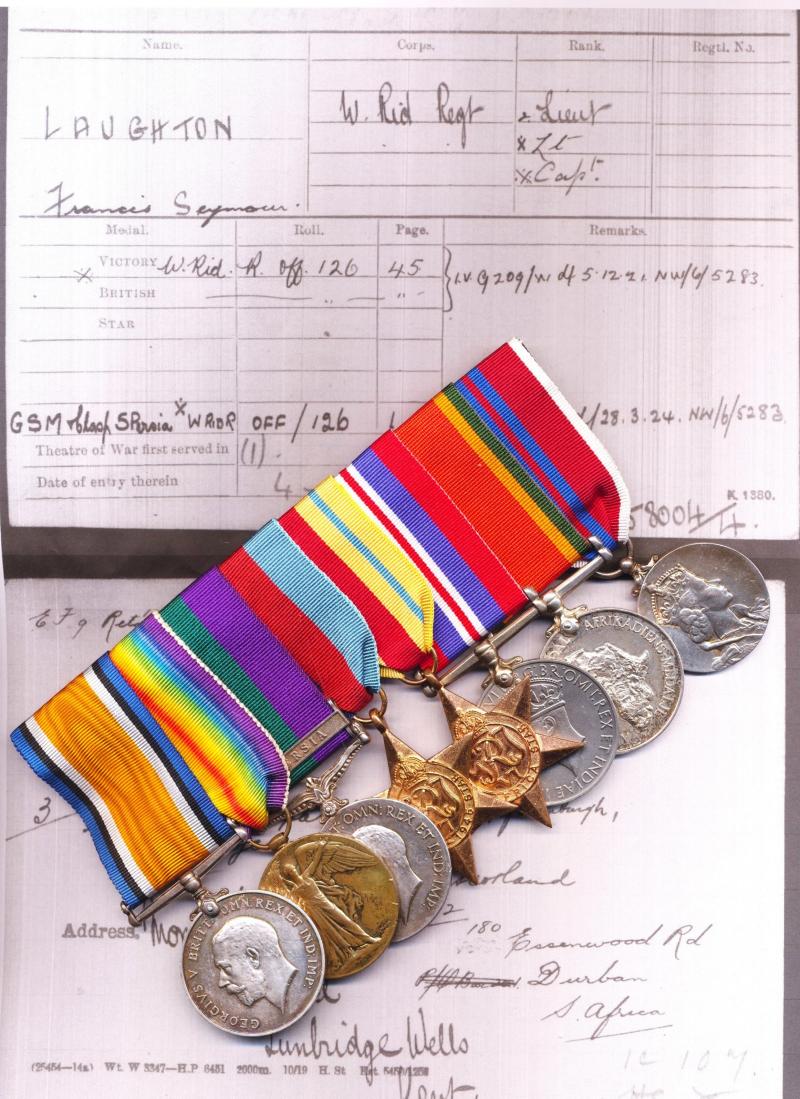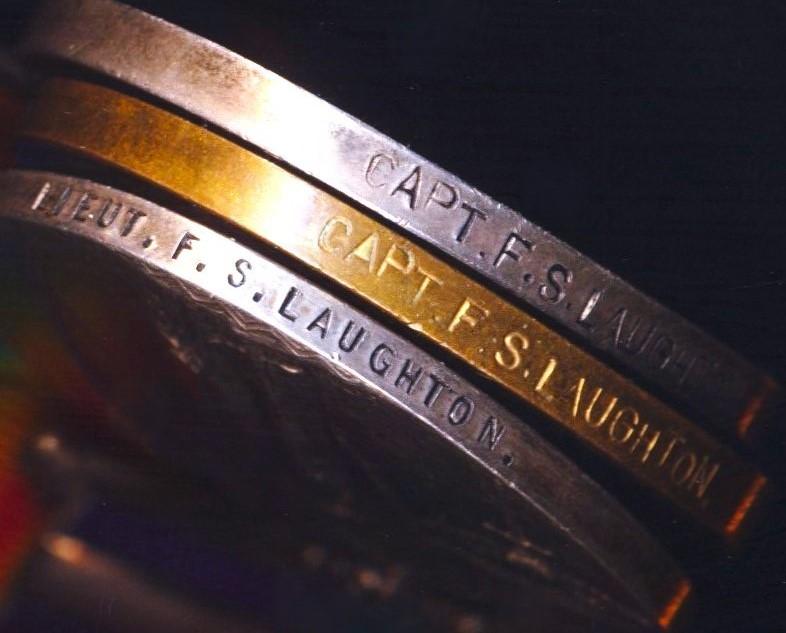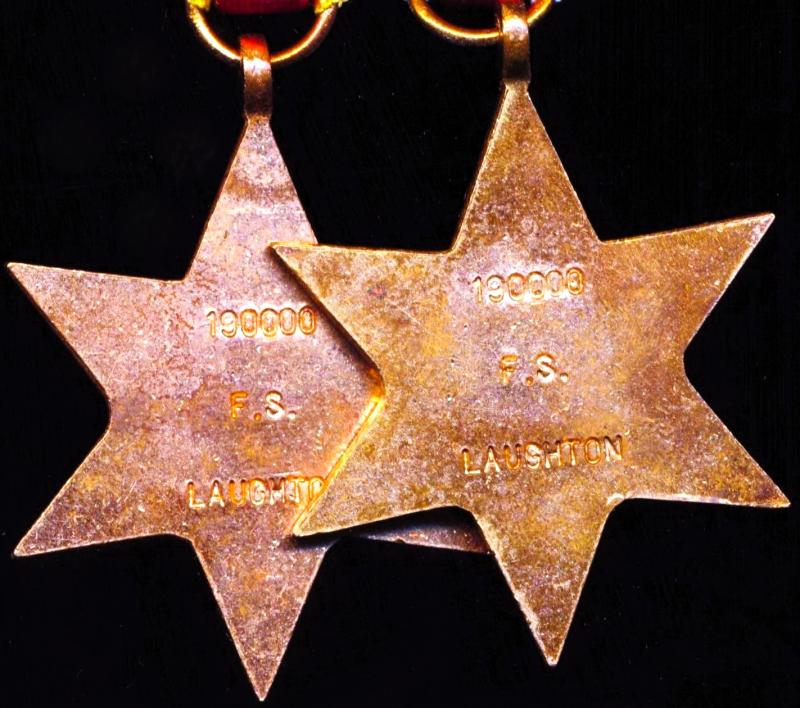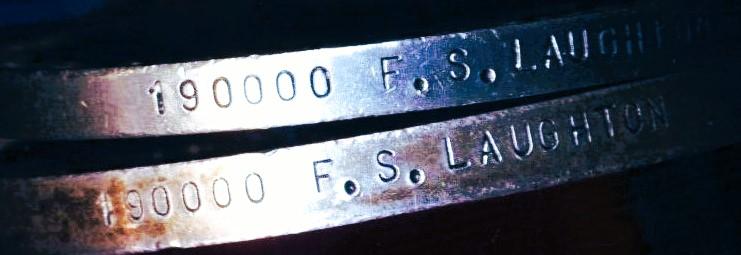The Duke's 'Regimentally Unique' medal group of 8: Captain Francis Seymour Laughton, 37th Forestry Company South African Corps of Engineers, late 1st & 2nd Battalion's The Duke of Wellington's Regiment (West Riding) and South African Forestry Service
- British War Medal. Silver issue (Capt. F. S. Laughton.)
- Interallied Victory Medal (Capt. F. S. Laughton.)
- General Service Medal 1918-62. GV issue & clasp 'S. Persia' (Lieut. F. S. Laughton.)
- The 1939-1945 Star. No clasp (190000 F. S. Laughton)
- The Africa Star. No clasp (190000 F. S. Laughton)
- War Medal (190000 F. S. Laughton)
- Union of South Africa: Africa Service Medal (190000 F. S. Laughton)
- Coronation Medal 1953
Unique to Regiment Campaign Medal Clasp: The recipient, a serving officer of the 'The Duke of Wellington's Regiment (West Riding)', Lieutenant Frances Seymour Laughton, is confirmed as the unique regimental recipient of the General Service Medal with clasp 'S. Persia'
Medals verification: All medals and clasp verified as the recipients full medal entitlement, per below referenced sources:
- British War Medal. Silver issue: WO 329/2220 roll of 'West Riding Regiment'. Issued 5 December 1921
- Interallied Victory Medal: WO 329/2220 medal roll of 'West Riding Regiment'. Issued 5 December 1921
- General Service Medal 1918-62. Clasp 'S. Persia': WO 100/G10/420 roll of 'West Riding Regiment'
- The 1939-1945 Star. No clasp: Recipients SA service card refers
- The Africa Star. No clasp: Recipients SA service card refers
- War Medal: Recipients SA service card refers
- Union of South Africa. Africa Service Medal: Recipients SA service card refers
- Coronation Medal 1953: Coronation Medal Roll 'South African Allocation'
The Second World War campaign medals confirmed as the recipients full medal entitlement as endorsed on his service cards, showing that the medals were despatched to him on, 10 June 1953
Frances Seymour Laughton was born on 5 October 1898 at the newly-acquired family home “Eindrieck” at St. Thomas’ Road, Durban, Natal Colony, into a well-established family. He was the fourth son of F. A. and F. M. Laughton, and later acquired the nickname “Jones” (a famous cricket player of that era), when playing that game with his brothers. His father Frederick Augustus Laughton, KC (1854-1943), was an Advocate of the Supreme Court of Natal. He was also a member of the Manx Bar and appeared in the 1906 Natal “Who’s Who”.F. A. Laughton had was born on the Isle of Man and educated at King William’s College, Isle of Man. Frederick married the youngest daughter of the late John Bird, CMG: they had six sons.
Following the outbreak of the Great War, the young Francis “Jones” Laughton followed his brothers Edmund and Harald Laughton to England (apparently at his own expense) to join the British Army. Another brother, Roger, had already entered the German South West Africa campaign as a Pte. (SS/210) with 4th Mounted Rifles, Union Defence Force (UDF), and was later commissioned. Francis himself recalled (in May 1940): ‘After a six-month course at the Royal Military College, Sandhurst, I received my commission in October 1916.’ He had in fact Passed Out together with 600 Gentlemen Cadets: Laughton having been in the Guard of Honour of 30. Gazetted on 26 October 1916, 2nd Lieutenant Francis Seymour Laughton was commissioned into The Duke of Wellington’s (West Riding) Regiment, together with fellow brother officers Herbert Middleton Hands, and John Clarke Morris.
The Campaign in France: Following a period of leave and equipping, the newly-minted Second Lieutenant F. S. Laughton joined the 2nd Battalion of the Duke’s (West Riding) on 5 January 1917, having crossed over to France the day before.
The Battle of Arras: The Battalion War Diary detailed the movement from Bailleul aux Cornailles on 7 April 1917, along the Arras – St Pol Road. The next day was spent preparing for the attack, shown as “ATTACK”, underlined, in the War Diary.
9 April 1917: The Dukes (West Riding) took part in the “Battle of Arras”, as part of 4th Division, XVII Corps. The Battalion left specially prepared huts for the Assembly Area at 0520 hrs, and on arrival at 0810 hrs a hot meal was served and a Rum ration issued. 9th Division had meanwhile attacked and captured the German 1st and 2nd lines of trenches.At 1025 hrs the Battalion left the Assembly Line for Blue Line. 1425 hrs: arrived at Blue Line and remained until the Artillery had finished bombarding the Brown Line. 1525 hrs, the Battalion moved forward to the Brown Line in Artillery formation, but halted while the Artillery bombarded the German 4th System and the village of Fampoux. The Battalion moved forward at 1550 hrs from the Brown Line towards the German 4th System, following the King’s Own Royal Lancaster Regiment’s 1st Battalion which captured the 4th System. At 1640 hrs the Battalion passed through the King’s Own and advanced towards Fampoux in Artillery formation and sustained Artillery fire west of Fampoux. Here, 2nd Lieut. A. E. Taylor was killed and four Other Ranks wounded.1710 hrs: the Battalion commenced entering Fampoux but encountered heavy enemy Machine-Gun fire from the slopes on the Southern bank of the River Searpe. Little resistance was met until reaching the Eastern end of the village, where a few snipers had to be bombed out of the houses. 1735 hrs: the Battalion attempted to advance from the Eastern end of the village to the Green Line, 500 yards in advance of Fampoux but were held up by heavy Machine-Gun fire from front and flank. Further advance without Artillery preparation was not practicable and the Eastern edge of the village was prepared for defence.1800 hrs. Enemy was observed to be making a heavy counter attack on the Southern side of the River. At about 2000 hrs the battalion got in touch with the 2nd Battalion of the Lancashire Fusiliers who were operating on the left of Fampoux. Casualties: 1 Officer killed. 6 Officers wounded. 16 Other Ranks killed. 35 Other Ranks wounded. 2 Other Ranks missing. During the fighting at Arras on 9 April 1917, 2nd Lieutenant F. S. Laughton is confirmed being present as one of three Officers that served with No. 3 Company during the battle.
Wounded-in-Action: 2nd Lieutenant . S. Laughton is confirmed being in the attack at Arras on 11 April 1917, again with No. 3 Company. on which date the Battalion War Diary confirms that he was 'Wounded-in-Action' and 'Remained on Duty'
Promotion: The London Gazette issue of 18 October 1917, records that F. S. Laughton was promoted to Acting Captain 'While Commanding a Company' effective from 29 August 1917
Francis Laughton’s active War Service with the 2nd Battalion, Duke of Wellington’s (West Riding) Regiment, lasted from 5 January 1917 to 10 Mar 1918. He had commanded a Company as a 2nd Lieutenant (acting Captain) at the age of 18, and had been wounded, having taken part in two actions during the Battle of Arras
Decades later, when writing of meeting Francis at this time, his brother Edmund noted:-
I can picture Francis as a fine upstanding officer in the Duke of Wellington’s (West Riding) Regiment. He had passed out of Sandhurst with some 600 Gentleman Cadets and he was in the Guard of Honour of 30. His Regiment was drafted to France, with all the mud and filth of trench warfare. „Jones“ went into the fighting at the Chemical Works at Ypres with the rank of Lieutenant, and came out as an acting Captain at the age of 18, through casualties. The Battalion went in with a strength of 1,000, and came out with 400. He was given a few days of compassionate leave which he spent with me at Ellesmere Port, near Port Sunlight. I was in digs but had a large brass double bed which he shared with me. I could sense him trembling all through the night. We did not talk about it but in the morning „Jones“ was up and went to Mass, such a broken, shaken man. But what a change on his return! He was bright and confident again, sorry to have left his wonderful men in their need, eager to get back again to the hell that was let loose in those awful days.
2nd Lieut. F. S. Laughton relinquished his acting rank of Captain on 27 March 1918, as prelude to be seconded as a 2nd Lieutenant to the Indian Army, effective from 15 April 1918, and where at Agra, India, he was for a short period attached to the war raised 2nd Battalion 4th (P.A.V.O.) Rajputs, prior to being attached to the 94th Russells Infantry. Referring to his short-lived secondment to the Indian Army, he recalled in later years in his own words, when applying for a Commission in the Union Defence Force of South Africa during the Second World War;
Quote,
Thereafter I served a little over a year with an Indian Regiment in India and with the South Persia Field Force on the Persian Gulf before joining the 1st Battalion of my Regiment in Quetta, India in June 1919. In December 1919 I proceeded with the 1st Battalion to Palestine and in the following May I resigned my commission and was appointed Captain in the Reserve of Officers. I am now 41 years old and having led an active life as an officer (Research Officer) in the service of the Forestry Department in Knysna (Cape Province, South Africa), since October 1924, I consider myself still fit.
Unquote.
After leaving the British Army in May 1920, Francis Laughton, proceeded to Edinburgh, Scotland, whereat, he attended Edinburgh University for a degree course that resulted in him following a long and distinguished career as a Forestry Officer in South Africa. While studying at Edinburgh, his Great War Medal were forwarded to him care of the 'Forestry Department' Edinburgh University. He graduated with a BSc in 'Forestry' in 1924, returning to South Africa the same year to take an appointment as a Forestry Officer in Cape Province
Second World War and service in East Africa: Francis Laughton is mentioned in the history of the South African Engineer Corps („Salute The Sappers“), as the commander of 37 Forestry Company
Almost all Engineer construction tasks carried out in the East Africa Campaign required timber of some sort, and its provision was largely the responsibility of 37th Forestry Company, S.A.E.C, one of South Africa's most unusual units, formed and recruited at Knysna under Captain F. S. Laughton of the Union Forestry Department, with a nucleus of 2 officers and some 53 other ranks with an intimate knowledge of the work in the dense Tsitsikama and other forests along the Garden Route. By the end of August 1940, the company was felling trees, sawing and delivering sisal poles, bamboo and papyrus from Naivasha and from north of Gilgil, for building hutments. During the second half of October they were at work in the Elburgon Plantations, felling, preparing, transporting to rail, and loading poles for building at Gilgil. Meanwhile, a party had been on reconnaissance in Tanganyika, and by the end of October 37th Forestry Company, S.A.E.C. was settling in at Shume, on the crest of the Usumbara Mountains, to put back into full production the timber-mill owned by the Tanganyika Forest and Lumber Company, where they only ceased milling on 20 March 1941
Sold together with some 'Soft Copy' research, that will be forwarded to the buyer by email attachment
The group mounted in the swing-style. The medals suspended from a white-metal mounting bar, this retaining its long hinged pin and clasp fittings
A unique combination of medals to an officer of 'The Duke's'
Condition: GVF
Code: 24083



